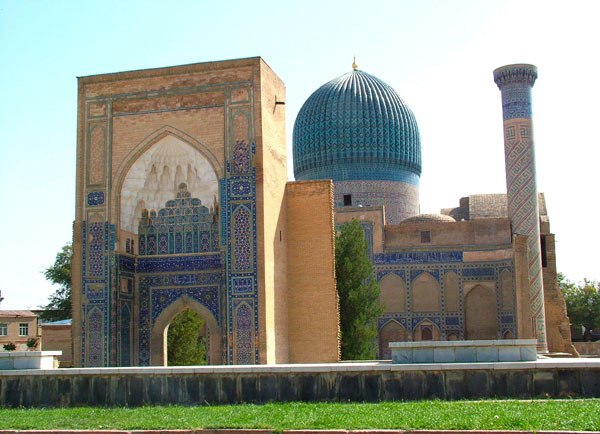Samarkand - ist eine der ältesten Städte der Welt mit 2750 Jahren der Geschichte, so alt wie Rom, Athen, Babylon. Die Stadt liegt am linken Ufer des Mittellaufes des Zarafshan River, im Herzen der Republik Usbekistan. In der Antike war es die Hauptstadt des mächtigen Staates Sogd. Am Eingang der Stadt blieb die Ruinen von Afrasi-ab, wo der alte Marakand stand, mit dessen Namen zentralasiatische Feldzüge Alexanders von Makedonien verbunden sind.
Samarkand war lange Zeit das auffälligste Objekt für Politiker, Geschäftsleute und Reisende. Es erreichte den Wohlstand und die Größe in der Zeit von Timur der Große. Die Stadt hatte eine günstige geographische Lage; es war eine wichtige Kreuzung auf der Großen Seidenstraße. Diese Ära hat die bedeutendsten Spuren in der historischen und architektorischen Erscheinung der Stadt hinterlassen.
Magnificent samples of medieval architecture affecting the perfection of forms and riot of colour, were kept in Samarkand.In Samarkand sind großartige Beispiele mittelalterlicher Architektur erhalten geblieben, die die Perfektion der Formen, den Reichtum der Farben auffällig sind.
 Die Sehenswürdigkeit der gesamten zentralasiatischen Architektur ist Samarkand Ensemble von Mausoleen von Shahi Zinda am Hang des Afrosiab. Die Gestaltung dieser Ensemble begann im XII. Jahrhundert, das Hauptgebäude wurde in den XIV-XV Jahrhunderten unter Timur durchgeführt. Das Ensemble wird von den Gräbern der Frauen der Familie Timur dominiert. Alle Gebäude sind reich an architektonischen Dekor: hier verwendet geschnitzt Mosaik Komponieren, geschnitzt glasierter Terrakotta, geformt und bemalt Majolika.
Die Sehenswürdigkeit der gesamten zentralasiatischen Architektur ist Samarkand Ensemble von Mausoleen von Shahi Zinda am Hang des Afrosiab. Die Gestaltung dieser Ensemble begann im XII. Jahrhundert, das Hauptgebäude wurde in den XIV-XV Jahrhunderten unter Timur durchgeführt. Das Ensemble wird von den Gräbern der Frauen der Familie Timur dominiert. Alle Gebäude sind reich an architektonischen Dekor: hier verwendet geschnitzt Mosaik Komponieren, geschnitzt glasierter Terrakotta, geformt und bemalt Majolika.
Registan ist eine Kombination aus majestätischer Majolika und azurblauem Mosaik.
Gur-Emir-Mausoleum (XV Jahrhundert). Timur mit seinen Söhnen und Enkelsöhnen wurde hier begraben. Die Grabkammer von Gur Amir wurde zum Prototyp des Taj Mahal in Agra.
Als "ein Wissenschaftler auf dem Thron", Patron der Wissenschaft und Bildung, Timurs Enkel Mirzo Ulugbek, ging in die Geschichte ein. Er sammelte hervorragende Wissenschaftler. Im Jahre 1420 wurde während der Ulugbek-Regierung das Observatorium gebaut. Die hier hergestellten Sternentafeln von Ziji-Gurgan haben bis heute ihre wissenschaftliche Bedeutung behalten. Vom Observatorium sind nur das Fundament und ein Teil des astronomischen Instruments - der Sextant - erhalten geblieben.
Der größte Wohlstand des Baus der Nekropole war im letzten Viertel des XIV. Jahrhunderts, der Zeit, als der Bau von Mausoleen von Timurs Familienmitgliedern, Militärführern und Adligen begann. Mehrere Gebäude des Ensembles "Shakhi-Zinda" gehören zur ersten Hälfte des 15. Jahrhunderts, der Zeit von Ulugbek.
Im Jahr 1997, anlässlich der Entscheidung der UNESCO, wurde das 1225-jährige Jubiläum des herausragenden Wissenschaftlers und Gelehrten des Ostens von Imam al-Bukhari gefeiert. Bis zum Jahrestag im Dorf Khortang in der Nähe von Samarkand, wo die großen mukhaddis begraben wurden, wurde das Denkmal restauriert.lich (die erste Hälfte des XV. Jahrhunderts) mit einer Kuppel auf einer hohen zylindrischen Trommel bedeckt, von ihnen verschieden.
Das antike Samarkand bietet seinen Gästen die einzigartigen historischen und architektonischen Denkmäler, die unnachahmliche Handwerkskunst, die Bräuche und die Feiertage, die Geheimnisse der orientalischen Küche.
Das moderne Samarkand ist eine gut geplante Stadt. Es gibt viele Parks und Gärten. Die Stadt wurde zu einem der wichtigsten Kulturzentren Usbekistans, sie hat die Universität, andere Bildungseinrichtungen, wissenschaftliche Einrichtungen, Opern- und Theatertheater und zahlreiche Museen.